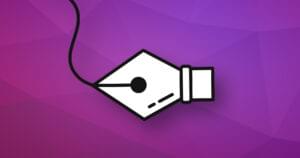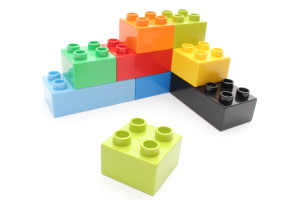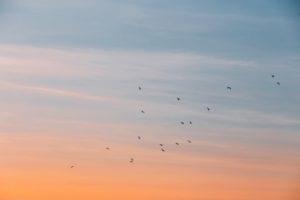<img> tag in sight!
How it Works
The above is basically a normal box that has an orange background colour, over which four corner images are superimposed. All these images have been called up through CSS commands. So, we start off with the following snippet:<div class="bl">Lorem ipsum dolor sit amet consectetur adipisicing elit</div>class="bl" as we’re going to assign our bottom right corner to this <div> through a CSS command. As a rule, you can only assign one background image to an HTML tag using CSS, so this is the only image we’ll assign to this <div>.
.bl {background: url(bl.gif) 0 100% no-repeat; width: 20em}- Image URL — Remember, the image is being called through the CSS, so the path to the image must be the path from the CSS document, not the HTML document.
- Image Position — In this example, we’ve used the command
0 100%in our CSS rule. The first number represents the distance from the left edge of the<div> ;the second number identifies the distance from the top edge. In this instance%was used, but a different distance value, such as em or px, could just as easily have been used instead. If this command was left out, the default value,0 0, would be used, and the image would be placed in the top-left corner. - Repeat Command — Obviously, we don’t want this image to repeat, so we insert the
no-repeatCSS command. If we wanted to, we could have usedrepeat-x, to repeat the image horizontally,repeat-y, to repeat it vertically, andrepeatto repeat it both horizontally and vertically. If this command was left out, the default value,repeat, would be used.
Bottom-Right Curve
Next, we’ll stick in that bottom-right curve. As previously mentioned, we can only assign one background image to each<div> in the CSS, so we’ll need to insert a new <div>:
<div class="bl"><div class="br">
Lorem ipsum dolor sit amet consectetur adipisicing elit
</div></div>.br {background: url(br.gif) 100% 100% no-repeat}Top Curves
To make our top curves, we’ll need two new images:<div>s for them:
<div class="bl"><div class="br"><div class="tl"><div class="tr">
Lorem ipsum dolor sit amet consectetur adipisicing elit
</div></div></div></div>.tl {background: url(tl.gif) 0 0 no-repeat}
.tr {background: url(tr.gif) 100% 0 no-repeat}Background Colour
We’ll now insert our orange background colour into the box, in order to achieve the whole round corners effects. The background colour must always be assigned to the very first CSS rule. This is because each CSS background rule is essentially a layer on top of the previous one. So, in this example, we have a layering order of br.gif, bl.gif, tl.gif and then tr.gif. But, in this example, the images don’t overlap, so we don’t really notice this layering effect. By default, a background colour covers the entire<div> and will layer on top of any other previously assigned background images and/or colours. Therefore, if we place the orange colour in any <div> other than the first, it will be placed on top of the preceding images and will essentially cause them to disappear. Therefore, we must place our orange background colour (#e68200) in the very first CSS rule:
.bl {background: url(bl.gif) 0 100% no-repeat #e68200; width: 20em}Padding
Padding is needed to prevent the text from overlapping on to the images, which are 10px x 10px in size. Therefore, we need 10px-worth of padding on the text. But to which<div> should we assign the padding CSS rule? Does it matter? Well, yes it does.
Whichever element we assign padding to, each of the elements inside it will inherit that padding. If we were to assign padding to the very first <div>, <div class=""bl">, we’d get this effect.
To get this padding to work properly, we need to assign it to the very last <div>, <div class="bl">:
.tr {background: url(tr.gif) 100% 0 no-repeat; padding:10px}Internet Explorer Issues
You may have noticed the bottom corners were called up before the top corners. If we were to do things the other way round, that is, call the top corners first, some parts of the orange background colour would sneak out under the bottom curves, causing a rather unsightly effect. Switch the order of the<div>s around and see for yourself.
Another issue in Internet Explorer is that the background colour of the box sometimes overlaps on to the element below, again causing an unattractive effect. This can be solved simply by placing a tiny placeholder beneath the box with round corners. Immediately after the fourth closing </div>, insert the following HTML:
<div class="clear"> </div>.clear {font-size: 1px; height: 1px}The Final Code
Our finished HTML now looks like this:<div class="bl"><div class="br"><div class="tl"><div class="tr">
Lorem ipsum dolor sit amet consectetur adipisicing elit
</div></div></div></div>
<div class="clear"> </div>.bl {background: url(bl.gif) 0 100% no-repeat #e68200; width: 20em}
.br {background: url(br.gif) 100% 100% no-repeat}
.tl {background: url(tl.gif) 0 0 no-repeat}
.tr {background: url(tr.gif) 100% 0 no-repeat; padding:10px}
.clear {font-size: 1px; height: 1px}Frequently Asked Questions (FAQs) about CSS Rounded Corners and Curves
How can I create a curved cutout on an element using CSS?
Creating a curved cutout on an element using CSS can be achieved by using the ‘clip-path’ property. This property allows you to define a specific region of an element to display, hiding the rest. For a curved cutout, you can use the ‘circle()’ function within the ‘clip-path’ property. Here’s an example:.element {
clip-path: circle(50% at 50% 50%);}
This will create a circular cutout at the center of your element. You can adjust the values to position and size the cutout as needed.
How can I draw a curve with CSS?
Drawing a curve with CSS can be done using the ‘border-radius’ property. This property allows you to round the corners of an element, effectively creating a curve. Here’s an example:.element {
border-radius: 50%;}
This will create a curve at each corner of your element, giving it a circular appearance. You can adjust the percentage to control the curvature.
How can I create different shapes using CSS?
CSS allows you to create a variety of shapes using different properties. For example, you can use the ‘border-radius’ property to create circles and ellipses, the ‘border’ property to create triangles, and the ‘transform’ property to create more complex shapes. Here’s an example of how to create a circle:.circle {
border-radius: 50%;
width: 100px;
height: 100px;}
And here’s an example of how to create a triangle:.triangle {
width: 0;
height: 0;
border-left: 50px solid transparent;
border-right: 50px solid transparent;
border-bottom: 100px solid red;}
You can experiment with these properties to create a wide range of shapes.
How can I style the borders of an element using CSS3?
CSS3 introduces several new properties for styling borders, including ‘border-radius’ for rounded corners, ‘box-shadow’ for adding shadows, and ‘border-image’ for using images as borders. Here’s an example of how to use these properties:.element {
border-radius: 10px;
box-shadow: 5px 5px 10px rgba(0, 0, 0, 0.5);
border-image: url(border.png) 30 round;}
This will give your element rounded corners, a shadow, and an image border. You can adjust the values to suit your design.
What are some tips for creating curved borders in CSS?
When creating curved borders in CSS, it’s important to remember a few key points. First, the ‘border-radius’ property accepts percentage values, which can be used to create elliptical shapes. Second, you can specify different radii for each corner of an element by providing multiple values. Finally, using a large radius can create a pill-like shape, which can be useful for buttons and other interactive elements. Here’s an example:.button {
border-radius: 50px;
padding: 10px 20px;}
This will create a button with pill-like rounded corners.
Trenton is crazy about Web usability and accessibility – so crazy that he went and started his own web accessibility and usability consultancy to help make the Internet a better place for everyone.



